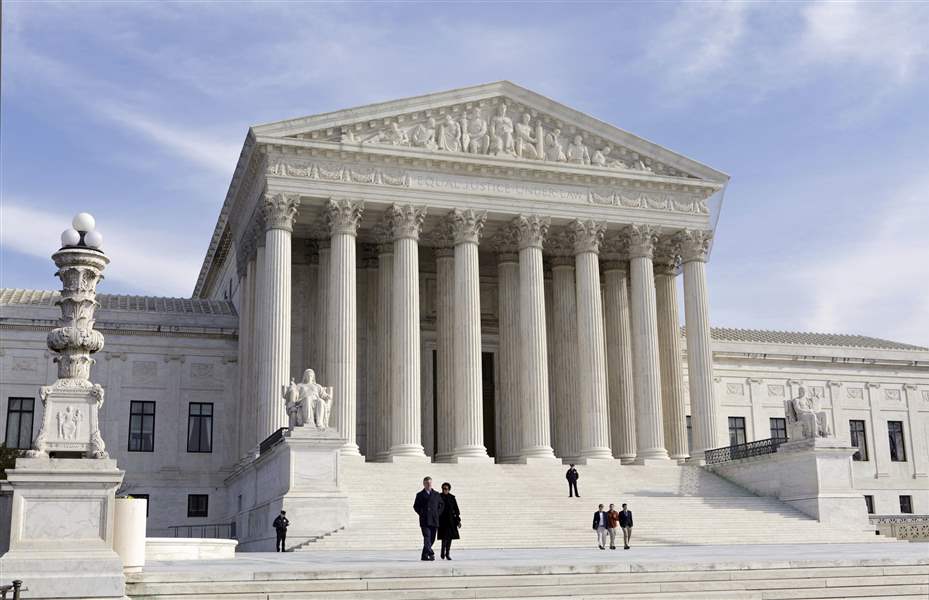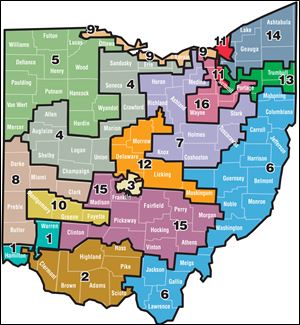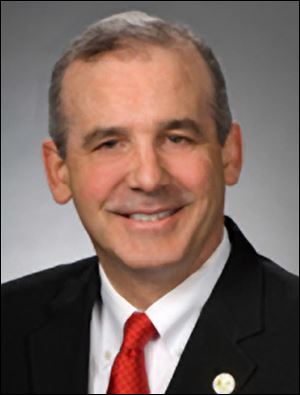
Supreme Court case could alter Ohio’s political map
6/25/2017

The Supreme Court announced this week that it would hear a historic redistricting case centered on the state legislative map in Wisconsin. The decision could have implications on Ohio's political landscape.
ASSOCIATED PRESS

Ohio Democrats are closely following a new U.S. Supreme Court case that could outlaw partisan gerrymandering, potentially reshaping the state’s electoral map from fractured Cincinnati to the snakelike sliver of a district that contains Toledo.
The Supreme Court announced this week that it would hear a historic redistricting case centered on the state legislative map in Wisconsin.
The court’s decision, which likely will not be announced before next June, could have major implications for Ohio, one of the most gerrymandered states in the country, law professors and election-reform advocates say.
“If the court finds that extreme partisan gerrymandering does violate the law, then we’ll be in court the next day,” said David Pepper, chairman of the Ohio Democratic Party.
Ohio has been a key battleground in the national debate over partisan gerrymandering — the practice of drawing district lines to benefit one political party at the expense of the other — since 2011, when the Republican-controlled legislature redrew the boundaries of the state’s 16 congressional districts. The resulting map helped Republicans win three-quarters of those seats in 2012, even though Ohio voters are evenly split between the two parties.
Democrats argue that the map makes little geographic sense. Cincinnati, which tends to vote Democrat, is divided into two separate districts. Lucas County is cut in two, with one piece, the 9th District, stretching from Cleveland to Toledo across two narrow segments of land connected by a bridge that is only 20 yards wide.

Redrawn boundaries of the 9th District forced two longtime congressional representatives — former U.S. Rep. Dennis Kucinich and U.S. Rep. Marcy Kaptur (D., Toledo) — to run against each other in a nasty primary battle. “It’s a very bitter experience to go through, and those who created the gerrymander, they just thought it was funny," Kaptur said.
In 2012, the redrawn boundaries of the 9th District forced two longtime congressional representatives — U.S. Rep. Marcy Kaptur (D., Toledo) and former U.S. Rep. Dennis Kucinich (D., Lakewood, Ohio) — to run against each other in a nasty primary battle.
“It’s not pleasant to run against one of your colleagues,” Miss Kaptur said. “It’s a very bitter experience to go through, and those who created the gerrymander, they just thought it was funny.”
For decades, the Supreme Court has been unable to settle on a legal standard to determine whether a particular instance of partisan gerrymandering is so egregious as to violate the Constitution.
The new case from Wisconsin, Gill vs. Whitford, proposes a formula for evaluating the extent of partisan gerrymandering by looking at “wasted votes” — the difference between the total number of votes cast for a party and the minimum number of votes needed to win the districts it controls. If one party regularly wins its seats by far more votes than necessary, that imbalance suggests its voters have been packed into relatively few districts in an effort to dilute their influence, the Gill plaintiffs argue.
Based on its “efficiency gap,” Ohio is among the dozen or so most gerrymandered states in the United States, according to the results of the 2016 congressional elections.
“The principles that the court articulates will have national ramifications,” said Edward Foley, a professor who directs the election law program at Ohio State University. “It’s not just about Wisconsin. It’s about Ohio and every other state.”
But Mr. Foley cautioned that the outcome of the case will likely hinge on the opinion of Justice Anthony Kennedy, a frequent swing vote on the court, whose views on the efficiency formula remain unknown.
And even if Justice Kennedy decides that Wisconsin’s map violates the Constitution, the court’s decision will probably be narrowly tailored to the specifics of the case, said Daniel Tokaji, a law professor at Ohio State.
“I don’t think they’re going to open the door to challenges of 50 states’ redistricting plans,” Mr. Tokaji said. “They’ll set a pretty high bar for what you have to prove in order to prove a partisan gerrymandering claim.”
Still, even a narrow verdict ultimately could apply to Ohio, given the impact of its congressional map on recent elections, Mr. Tokaji said. But the fact that nearly two dozen Democrats in the General Assembly voted for the final version of the 2011 map may make it difficult to prove that the redistricting plan was intentionally partisan, he said.
“A case of intent would be a bit more challenging, because there were a number of Democrats that signed on to the plan,” Mr. Tokaji said. “That makes it a little more difficult, at least optically, to mount a partisan gerrymandering claim.”
Given the uncertainty of the judicial process, local activists are not counting on the courts to prevent gerrymandering in Ohio.
A ballot measure to reform the redistricting process for the state legislature, in part by creating a bipartisan commission to make redistricting decisions, was approved resoundingly in 2015, with public support from both Democratic and Republican legislators. Now, advocacy groups hope to put on the ballot an initiative that would extend similar reforms to the congressional redistricting process as well.
While the Supreme Court case looks at already-drawn political maps to determine whether partisan tactics sometimes cross constitutional lines, the ballot initiative is designed to reform the entire redistricting process to prevent gerrymandering in the first place, said Carrie Davis, executive director of the Ohio chapter of the League of Women Voters.
“We’re certainly very excited about the Supreme Court taking up the case, but that does not impact our ballot initiative at all,” Ms. Davis said. “The Wisconsin case is exciting, but it’s addressing one piece of gerrymandering, and our issue does more.”

Huffman
But local Republicans say redistricting is not the reason that Democrats make up only a quarter of the state’s congressional delegation. State Sen. Matt Huffman (R., Lima) — who campaigned for the 2015 ballot measure but does not believe those reforms should be applied to congressional redistricting — said the Democrats lose elections in Ohio because “the coalitions that make up the party just aren’t that cohesive.”
In any case, the new reform effort is unlikely to come to fruition this November. Ms. Davis said it would be difficult for organizers to gather enough signatures by the July 5 deadline to get the initiative on this year’s ballot, meaning the referendum probably won’t take place until 2018.
So for now, the spotlight remains on the courts. Gill vs. Whitford is one of several gerrymandering cases working their way through the judicial system, including one in Pennsylvania that involves a strangely shaped congressional district said to resemble “Goofy kicking Donald Duck.”
Ohio Democrats considered filing their own redistricting lawsuit in 2012, said Chris Redfern, who chaired the state party at the time. Instead, the Democrats sought to overturn the congressional map through a referendum, but they failed to collect enough signatures to get the issue on the ballot.
Mr. Redfern blames that failure on the Democratic National Committee and the Democratic Legislative Campaign Committee, both of which refused to fund the signature-gathering effort, he said.
“The debate we had at the time was should we go through the legislative process or through the legal process,” Mr. Redfern said. “At the end of the day, we didn’t have the resources to do both. We barely had the resources to do one.”
That failure has proved costly for Ohio Democrats. After a series of disappointing elections, the stakes in congressional redistricting are now too high for the party to abandon state-level reform while the U.S. Supreme Court deliberates, Mr. Pepper said.
“There’s a huge brush fire exploding around this state to end gerrymandering one way or another,” he said. “It’s probably less than 50-50 that the [Supreme Court] case goes the way we want it to, but right away the citizens can take control of this on their own. And that’s what we’re doing.”
Contact David Yaffe-Bellany at: dbellany@theblade.com, or 419-724-6050.